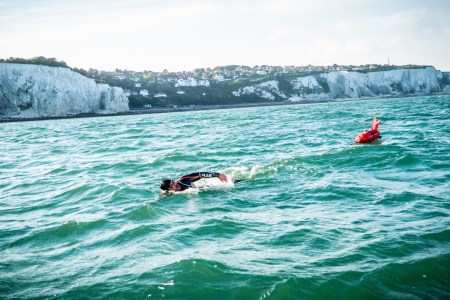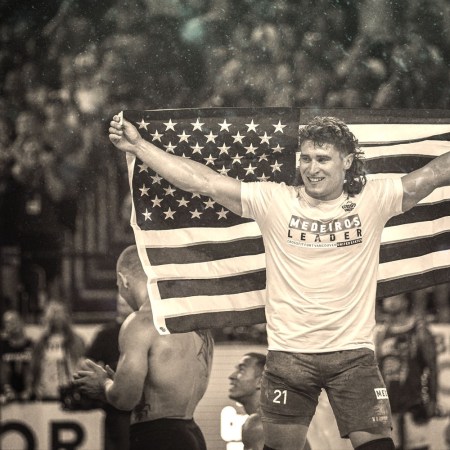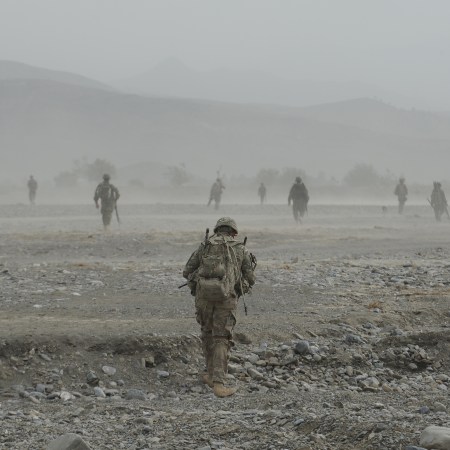Devon Lévesque is one of the best follows on social media. The former college athlete is an unrelenting force of nature, relied on by nearly a half-million Instagram followers for offbeat workout schemes, motivational musings and endless positivity. He keeps diverse company — NFL star Odell Beckham Jr., private equity billionaire Barry Sternlicht and mountaineer Nimsdai Purja are all friends — and observes a demanding daily routine, which has been known to start at 2 a.m. and invariably includes a trip to the sauna and a dunk in a freezing cold ice bath.
Perhaps most impressive about the man, though, was his unfathomable take on the marathon — 26.2 miles by way of bear-crawling, which he completed to raise awareness for suicide prevention. In this modern age, having a massive online audience can open a lot of fancy doors, but Lévesque has focused more on opening minds — while opening up the world of wellness along the way. We recently sat down with one of social media’s most interesting men to discuss his surreal journey of viral videos, world records and entrepreneurship.
What were your first experiences in the gym?
My fitness journey goes all the way back to my childhood. Both my father and my mother were professional weightlifters. So all of my siblings and I grew up in a very health-oriented household in New Hampshire. There was no junk food around and a pretty awesome gym in the house. I mean there was even a chin-up bar in our living room, right there. Before we went to bed, my sisters and I would either do dead hangs on it or pull-ups. There are pictures of me at two years old, hanging from a chin-up bar. So as long as I can remember, I’ve been working out in some shape or form.
What was it like growing up in that kind of environment, and how did it shape who you became?
Instead of sitting in front of the television, my parents were having me get outside to work or jump around on the trampoline. So that’s where I remember being, with my two friends Curtis and Greg, just trying to land backflips nonstop. Or maybe we would have a basketball on there, trying to do trick shots or see if we could tackle each other to the ground. I would even bring my snowboard onto the trampoline and try to land different kinds of tricks.
I also played just about every sport you could do in school: basketball, baseball, football, gymnastics, anything else. My team actually won a national championship. I was recruited by a few colleges, which eventually led to a scholarship. I played football and baseball competitively. In football I played cornerback and a slot receiver. I’ve always loved competing.
When did you first begin posting training videos on social media?
I was working in nightlife between Hoboken and New York City, throwing parties right out of college. I dropped out after I got the position. But I was also constantly working out. I went to a bar one day with my buddy DJ Sackmann who told me how impressed he always was with my workouts. He appreciated that I was trying things that aren’t usually expected when it comes to in the gym. He was the one who pushed me to post a few of them on my Instagram.
The first video that I posted on Instagram was me with these two kettlebells. I was just curious if I could jump from yoga ball to yoga ball while holding the kettlebells. I was able to do it in something like five tries. I posted it and was shocked when it started to get tens of thousands of views. Next there was this pretty crazy plank that I did, and I started to get sites like Barstool and ESPN reaching out, asking if they could repost them. I didn’t know the kinds of attention they would get, thousands and thousands of views, because that was just what I always did. This was before social media was filled with a lot of doctored, stunt videos, so I think it hit at just the right time.
How did you start doing things like that in the gym?
I would say that I rarely do the traditional movements like bench, burls or squats because I have been there and done that. I am kind of bored of all the usual things that people do when they first start going to the gym. Because I’m going into the gym every day, I make it a goal to try and see what my body is capable of. I’m not looking to break my ankle or arm during a workout, but I’m also not scared to push the limits a bit. That is where you really learn about yourself. There are a lot of people who only have an experience like that a few times during their lifetime, but I’m determined to feel that every single day.
What kind of reactions did you get from those first training videos?
I just started getting hundreds of DMs from people saying that I was an inspiration for them and that they didn’t know the human body was capable of some of the things that I was doing. I have to say that helped spur me on.
Speaking of reactions, you do a lot of these workouts in gyms with people around. What is the reaction like in the room when you’re putting together one of these training videos?
One thing that I have learned about myself is that I thrive with an audience. By myself in a quiet gym, I’m not going to perform as intensely as I would surrounded by a crowd of people cheering me on. Even back when I was playing sports, on game day I got a huge rush. I always saw that reflected in my performances. The videos usually start with me just saying to a friend that I want to try something a little wild, so I will start trying it out. Next thing you know, someone stops in the middle of their workout to watch, and then another.
Soon enough there is an audience of like 50 people standing around while I try to do a backflip off of a treadmill with a medicine ball to my core. The crowd helps me stay focused because there’s simply no shot I’m going to skip a rep or go at half-speed if a bunch of people are watching. The energy in the room during those training sequences is electric. The best part is that unlike the social media response, I actually get to see the effects of that energy immediately. Because people who were watching generally start pushing themselves a little harder in their own workouts. They might not be doing backflips, but I’ll see them sprinting where they used to be running.
Can you describe the thought process when you are building one of your unique workouts or sequences in the gym?
I remember one day I was doing a bunch of traditional squats, six sets of 12 reps. I started to wonder if I could do a squat, rack it, do a muscle-up and then come back to squat with the same bar. People watching were looking at me like I was doing something insane, but really if you think about it, it’s just a superset. So it was accomplishing what I needed it to, while making those sets more interesting.
Eventually you started to take these physical feats outside of the gym. I remember when you bear-crawled the distance of a marathon, raising awareness for mental health and suicide prevention. That was an incredibly remarkable challenge. How did it come to be?
I was in England with my buddy Ross Edgley, who is not only a crazy physical specimen but also one of the nicest human beings you will ever meet. He said that I had all of these great videos on social media but needed to bring them out into the real world and do something outside of the box gym. He thought I needed something that couldn’t be measured by likes or views — something that could have a tangible impact on our society.
He’s done all of these incredible feats for charity and awareness, whether it’s swimming around Great Britain without touching land or climbing the height of Mount Everest on a rope. These are things that money can’t buy, can’t be given. They are earned and undeniable. So he told me that I should bear crawl a marathon, and at first I told him that it was crazy. But it wasn’t long before I started to realize that it was exactly what I needed to do. It was on my mind. I started to think back to my days at football practice where we would bear crawl the football field, and I was really good at it. There was a natural ability there that I could lean into.
How I Swam Around the Entire Island of Great Britain
All it took? 157 days, 1,792 miles and more than a few mental pep talksSaying you’re going to do something like that and actually doing it are two different things. How did you go about committing yourself to the task?
I have to say it was on the plane back from England with Ross that I really started to put it in motion. I messaged 20 of my friends when I got back into the States and told them I was going to bear-crawl a marathon. I also knew that I wanted the crawl to have more purpose than just the feat itself, and decided that I would do it to raise awareness about suicide and mental health. My father took his life when I was 16 years old, and I had never really talked about it before then. I knew this would be a good message to get into the world, but it was also an opportunity for me to selfishly begin to heal my own wounds from losing my father. And if I could affect one person through the process, it would be more than worth it.
How did you go about training for something as unique and unusual as bear-crawling a marathon?
The very next day after I committed to it, I tried bear-crawling one mile, and it was one of the most miserable things ever. I thought to myself, “What the fuck am I doing?” I had already told those 20 people and now I was doubting if I would even be able to come close to doing it. I was doing it on turf in a gym, and it took me around two hours for a mile. I was starting to do the math in my head — it would take me like two days to do a full marathon at that kind of a pace. But there was no going back at that point, I had to find a way. I gave myself a year to prepare to do it.
Nobody had attempted to bear-crawl that distance before, so when it came to training for it, I was really on my own. There was no YouTube tutorial or training manual that I could purchase. I began by combining the hyper training that I do along with marathon training because I knew I needed that endurance. I also think sometimes people want the answers to be more complicated than they really are, but if you want to bear-crawl a marathon, you need to start bear-crawling long distances. So that’s what I started to do, bear-crawling miles every day, and I was going to bed with these epic aches. But I had to train my body to be used to that impact and strengthen those areas. I was bear-crawling every day for a full year, leading up to the full attempt.
What would a typical training day look for you every day for that year leading up?
I woke up at two in the morning, and I would train for six hours. I put these circuits together on a football field because if you go around a football field, that measures out to a quarter of a mile. I would put a circuit together and have in my mind that I would be definitely bear-crawling a mile that day. I would do one lap of the field in a bear-crawl, then do two sprints down the field, then a reversed bear crawl for 200 yards, then handstand walk for 50 yards. I would repeat that at least four times. If I was feeling frisky, I would repeat that eight times.
On occasion, I would bear-crawl an extra two miles after all of that. That would take me hours to do. It really hits the shoulders in a powerful way. With bear-crawling, you’re hitting your quads and shoulders a lot. Your wrists are taking a lot of punishment as well, so I did a lot of stretches and mobility there. The circuit kept me from getting too bored. After those six hours, I would go and do my normal work day. I would go to bed around 7 in the evening, and I programmed my body to wake up around two in the morning. I decided not to use an alarm because I wanted to wake up more naturally, as it’s such an important part of recovery.
Speaking of recovery, what do you normally do and what were you doing around this time?
Every single day, I hit the sauna and cold plunge back to back. I don’t even think about it anymore, it’s just an undeniable part of my day. I would do a massage gun when I needed to and threw on the Normatecs for a good chunk of the day as well. On a higher level, I did exosomal therapy, which is a kind of treatment similar to stem cells. I had those injected into my knees and legs.
Take me into the night before and the day of actually doing the marathon bear crawl.
The night before I did it, I had a ton of anxiety. But I went to sleep early and woke up in the zone. There were a lot of people in the house helping me get ready, but I didn’t talk to anyone. I put my music on, gospel music on repeat. My mom wrapped my hands. Everyone was around me and supporting me with the food. I even had people whose job it was to stop traffic as we were crossing streets. My mental health coach Johnny Martin gave a nice pep talk before we started.
I started at five in the evening when it was one of the coldest days of the season. I had to bundle up a little more. The first mile I went way too fast. One of my buddies tried to tell me to slow down, but I just said that I would slow down when I was done. I think the first mile only took me 25 minutes. I would stand up between the miles to shake out my arms, and when I did, I made sure to walk back a yard or two just to be sure I wasn’t doing any less than a marathon. I was listening to my gospel music during the early moments of the run. I really love gospel music because it makes for a good pace — slow and powerful, building to something.
I was going over the Brooklyn Bridge around the 11th mile, and that’s just a cool walk around midnight, going over these wooden beams. I got over the bridge and hit Park Avenue, and that’s when this super annoyed mentality hit me. My headphones died, my hands were freezing, my body was shaking and I just was pissed that I wasn’t even halfway done. I was throwing up the whole way. But one of my friends started just yelling at me, and I needed that. I pulled myself back into it.
The only time I got really amped up was the last half-mile of the effort. That’s when I started to see hundreds, thousands of people in Central Park ready to welcome me at the end. The music was turned off and I was just listening to the crowd and everyone that was there. I felt amazing after. It’s something I am really proud of.
Did you chat with Edgley after you completed the task?
I talked to him a few times. Ross congratulated me. That’s one of the best kinds of guys to have around because he’s always asking what’s next.
Speaking of what’s next, you are in the midst of your latest challenge — climbing the tallest mountains on every continent. How did you get set on this path?
I was hanging out with my friend Barry Sternlicht, and one of the people we were there with was doing the seven summit challenge. I started to research the best mountain climbers in the world, and this name Nimsdai Purja kept coming up. And this name Colin O’Brady kept coming up. The beauty of social media is that we have this connection to almost everybody, so I just DMed them to say what I wanted to do. Colin hit me back almost immediately and offered to jump on a call, and I was on the phone with him for two hours. Nims also hit me back, and this was right before his Netflix documentary came out when he was still sort of accessible to a point. Nobody knew what was about to happen with his career.
I reached out to my friend Greg Hewitt about which mountain I should take on first. I bought all the gear I needed at the bottom of the mountain. I have since learned that you need to break in your gear, or you are going to get blisters. I didn’t have the proper layers on or really understand altitude training. I put on these skis to climb the mountain, was falling over and was just exhausted on the way up. I submitted. I learned so much just by putting myself out there and trying it out. That is one way I know to always get better, getting yourself out there.
What is it like climbing with Nims?
Nims and I did Aconcagua in Argentina together. We just went full force with it. You’re supposed to take 10 to 12 days to acclimate, but we did the climb in 24 hours. There’s no question that climbing with Nims is special because you know you are with one of the best to do it. There’s comfort there, but also a motivation there to push yourself to keep up with someone who does it so easily. There was a group of 20 people with us at the beginning, but not all of them made it through the whole climb. Some people were getting altitude sickness. Getting to the top was epic, but the real challenge came on the way down. We made it to the second base camp where we were supposed to hang out for a bit, but Nims turned to me to say, “Do you want to just head now?” I said sure, but I thought he meant we were going to walk down. The descent usually takes two to three hours, but we did it in like 20 minutes. I was so tired, but I was honored to get that kind of respect from him, believing I could hang. I was just focusing on his feet, making sure that every time his feet hit the ground, mine did too. Somehow I made it, and next thing I know we are enjoying a bottle of wine at the bottom. It was incredible.
On top of climbing some of the world’s tallest mountains, you also seem to have an endless amount of projects in the works. What’s coming next?
I have become friends with a lot of amazing people, and I love getting to work with my friends. Being an athlete, I know how important the right nutrition is, so one of the companies I’m excited for this next year is Promix. We just had Odell Beckham Jr., who’s a friend, come on as an investor and partner.
I also have a lot of fun working with my friends at Cuts and Super Coffee, who I have learned from so much when it comes to business. I am really excited this next year as we continue to build All Day Running. Plus, I’ve met a lot of people through the 29029 Everesting event with Jesse Itzner and Colin O’Brady. Together, we’re working to create a massive running community with these “all day” events, as I know there is so much opportunity there. There’s nothing better than connecting with people after a great run, or any intense effort like that. On that concept of connecting with great people, I also built a ranch, Cedar Trunk Ranch, with my friend Jimmy DeCicco from Super Coffee. We’re hosting our next weekend retreat this January. I am excited to host people, get my friends together and have unforgettable conversations.
This article was featured in the InsideHook newsletter. Sign up now.






















